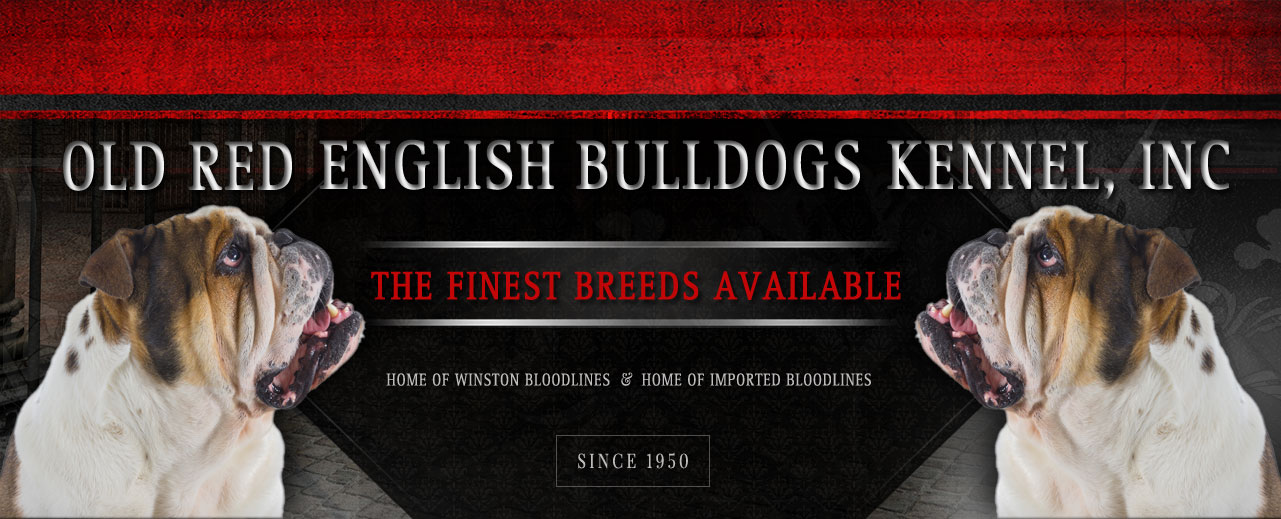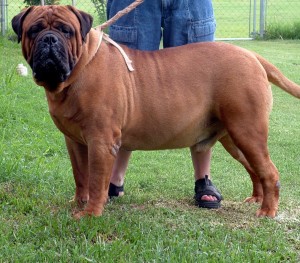The Bullmastiff is a relatively young breed, although its primary ancestors are quite old. The Bullmastiff is the result of crosses between the English Mastiff and the Old English Bulldog. These crosses began to be initiated in an organized way in the 1860s, although it is possible that these two breeds had been mixed for centuries before that. Along with both the Mastiff and the Bulldog, the Bullmastiff is a member of a group known as Molossers, also called Alaunts, Mastiffs, or Dogues. This group is quite ancient, and much of the information surrounding its origin is disputed. The word “Mastiff” itself is even debated. Some scholars believe it is the modern form of the ancient Anglo-Saxon word “masty,” meaning powerful. Others believe it is the Anglicized version of the old French word “mastin,” which loosely translates to tame. Regardless of where the modern name came from, it is undeniable that Mastiff-type dogs have been present in the British Isles for many centuries.
There is also controversy surrounding the mystery of how the first Mastiff arrived on British soil. There are at least four viable possibilities. Based on surviving breeds across Europe and Asia, it is believed that the earliest farmers in the Middle East developed a large, livestock guardian breed similar to the modern-day Great Pyrenees or Akbash Dog. These dogs spread across Europe with agriculture. Such dogs (now known as Lupomolossoids) may have arrived in Britain thousands of years ago to defend sheep and goats from predators like wolves. Although not true Mastiffs, the ancient Britons could have selectively bred these dogs until they became Mastiffs. Depictions in ancient Mesopotamian and Egyptian artwork show dogs very similar to the modern Mastiff between 5,000 and 7,000 years ago. These drawings typically show these dogs in a combat role, although some also depict them guarding livestock. This region was also home to a people known as the Phoenicians, who were famous across the Mediterranean as traders. Many stories claim that Phoenician traders brought the first Mastiff to England on a voyage of trade and discovery. However, this story is impossible to verify and is unlikely for many reasons, not the least of which is that it would have been very hard to transport such a large dog such a long distance by sea in ancient vessels. In truth, the validity of either of these theories is difficult to assess, as almost no records exist of pre-Roman Britain. What is known for sure is that some type of massive guardian dog was present in Britain prior to the Roman conquest.
When the Romans first invaded what is now England and Wales, they faced stiff resistance from the native Celtic tribes. These tribes employed a giant war dog that greatly impressed the Roman army. The Romans called this dog the ‘Pugnaces Britanniae.’ Most scholars believe this dog was a Mastiff, while others believe it was more similar to the Irish Wolfhound. Prior to the conquest of Britain, the Roman army used a war dog known as the Molossus, which had been developed by the tribes of Epirus (modern-day Albania, Greece, and Montenegro). Some scholars insist that the Molossus was a Mastiff, while others claim that it was a smaller, more general-purpose dog. Either way, the Molossus was almost certainly crossed with the Pugnaces Britanniae in Britain and across the Roman Empire, which likely resulted in a dog very similar to the modern Mastiff, though probably not as short-faced.
With the eventual fall of Rome, a number of barbarian tribes ravaged the Western Empire. One of these tribes was the Alans, a people native to the Caucasus Mountains. The Alans were primarily known for their ferocious war dogs, known as Alaunts after their owners. The Alaunt was almost certainly a breed of Owtcharka (giant livestock guardian breeds native to the Caucasus), and many scholars claim that all Mastiff-type dogs are primarily descended from the Alaunt, with this breed likely contributing to the brachycephalic (pushed-in) face seen in modern Mastiffs. It is possible that Alaunt blood was added to existing British dog blood during the chaos following the fall of Rome or when the Normans conquered Britain, bringing their own Mastiff-type dogs.
However the British Mastiff developed, it evolved to become primarily a protector of property. It was customary for these massive dogs to be kept on a chain, earning the name ‘Bandogges’ (a 13th or 14th century Middle English term referring to a Mastiff-type dog bound by a chain during the daytime and released at night to guard against intruders). These original Mastiffs were bred not only for extreme size and power but also for ferocity and protective instincts. Eventually, a sport known as bear-baiting developed, in which a chained bear would fight several Mastiffs. The result was always the death of the bear, but a typical match usually resulted in the death of several dogs as well. Neither bear baiting nor property protection required the Mastiff to be especially athletic, and the breed became quite slow. In 1835, bear baiting was prohibited by Parliament, and the hyper-aggressive Mastiff of the time, unable to be used for this purpose, soon found its employment opportunities dwindling. Social mores were also changing, especially in the ever-growing cities, and Mastiff breeders no longer wanted a dog that would aggressively attack an intruder. They instead sought dogs that would pin someone down and hold them until their owners could judge the situation. By the 1860s, the Mastiff had become much less ferocious than its ancestors.
Although not as vicious as its predecessors, the 19th-century Mastiff would evolve through crosses with Bulldogs to find employment with British game wardens, defending wildlife parks and private hunting reserves of the wealthy from poachers. These poachers, unlike modern-day poachers who kill endangered animals for valuable parts, were mainly hunting for food, often targeting rabbits and deer. While many poachers were armed with guns, their primary hunting method involved using Longdogs (crosses between two sighthound breeds) or Lurchers (crosses between a sighthound and another type of dog) to chase and subdue prey. Because the penalty for poaching was high, poachers were often willing to kill or seriously injure a warden to avoid capture. Game wardens needed a dog capable of not only protecting them but also running down and subduing the poacher. Although Mastiffs were capable of subduing poachers once they caught them, they were usually not fast enough. As the years passed, most Mastiffs lacked the aggression to fight a determined or armed poacher. A new breed would need to be developed.
For many centuries, bull baiting was a popular sport in England. Similar to bear baiting, bull baiting involved Bulldogs attacking bulls. The ancestry of the Bulldog is unclear, but it is likely descended from small Mastiffs crossed with other dogs or possibly Alaunt-type dogs imported from Spain. Bulldogs used for bull baiting were much lighter in build than their modern descendants. These dogs were extremely muscular without being overly thick and were somewhat taller than modern English Bulldogs. Bulldogs were known worldwide for their fearlessness and tenacity, attacking any opponent regardless of the odds or the severity of their injuries.
Like bear baiting, bull baiting was banned in England in 1835. However, Bulldogs were smaller and easier to keep than Mastiffs, and bulls were much easier to acquire than bears. Bull baiting enthusiasts were able to continue their activity illegally for many decades, breeding Bulldogs that remained just as fierce as their ancestors. This ferocity may have increased as dog fighting became a popular underground sport, filling the void left by the end of bull and bear baiting. As the Mastiff became less well-suited for game warden duties, Bulldogs were tested, but they were too aggressive. Bulldogs often attacked poachers rather than subduing them, and they frequently ignored the game warden’s commands to go after the poacher’s dog or another creature. Sometimes, Bulldogs would even attack the game warden.
It may seem strange that game wardens did not simply use breeds like the German Shepherd or Doberman Pinscher, but in the 1860s, these breeds had not yet been fully developed, and importing a foreign dog would have been too expensive. Game wardens began crossing Mastiffs and Bulldogs until they produced the dog they needed. This cross likely had been made for centuries, but in the mid-19th century, breed standardization and dog shows were becoming popular across the United Kingdom. Game wardens likely got caught up in this trend and sought to develop a distinct breed. The ideal proportion was 60% Mastiff and 40% Bulldog, creating a dog with the size and power of a Mastiff, along with its reserved attack, yet still retaining the athleticism and ferocity of the Bulldog. Breeders also selected for the ability to trail a poacher quietly for a long period, then burst into action to subdue him. Game wardens preferred brindle dogs, as it provided camouflage at night. They called this new breed the Bullmastiff, much like Bulldog/Terrier crosses became known as Bull Terriers. The Bullmastiff was fully standardized by the early 20th century.
Though originally a utilitarian game warden’s dog, the Bullmastiff quickly gained popularity with other fanciers. Smaller and easier to keep than the Mastiff, the Bullmastiff became a popular urban guard dog. The same traits that made it useful to game wardens—subduing rather than attacking, but willing to do so if necessary—also made it desirable for property owners. Many new admirers were dog show enthusiasts, and the fawn coat pattern was favored over the brindle. In 1924, the Kennel Club formally recognized the Bullmastiff.
Since the early 1900s, many Bullmastiffs had been imported to North America, where they were often used as guard dogs for estates. The breed’s history was shaped by the time it spent with game wardens, and their usefulness as protectors has only been amplified with the passage of time.

